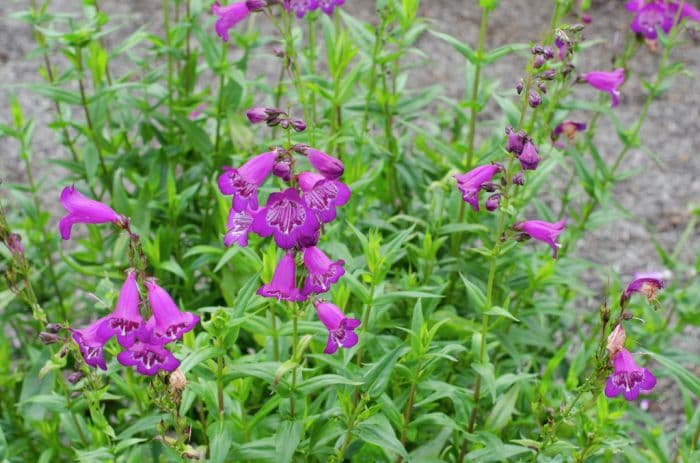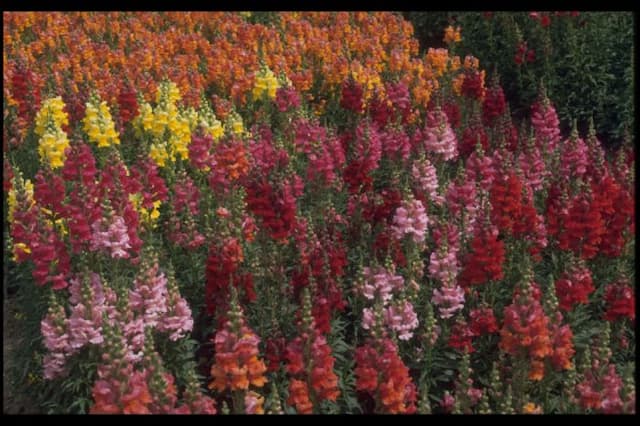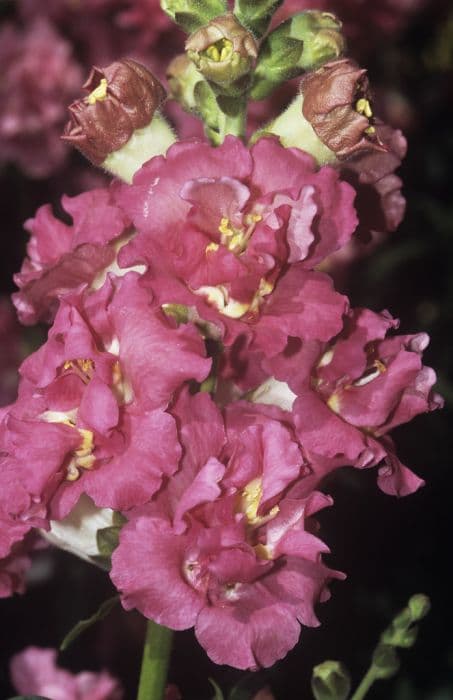Penstemon 'Pensham Blueberry Ice' Penstemon 'Pensham Blueberry Ice' (Pensham Series)

ABOUT
This selection bears blue flowers with clear white throats. Height to around 80cm
About this plant
 Names
NamesFamily
Plantaginaceae
Synonyms
Beardtongue, Blueberry Ice Beardtongue
Common names
Penstemon 'Pensham Blueberry Ice' (Pensham Series).
 Characteristics
CharacteristicsLife cycle
Perennials
Foliage type
Deciduous
Color of leaves
Green
Flower color
Blueberry
Height
2 feet 6 inches (76 cm)
Spread
2 feet (60 cm)
Plant type
Herb
Hardiness zones
5
Native area
North America
Benefits
 General Benefits
General Benefits- Attractive Flowers: Penstemon 'Pensham Blueberry Ice' boasts beautiful blue-purple flowers that add vibrant color to gardens and landscapes.
- Long Blooming Period: This plant typically enjoys a long flowering season, often from early summer to early fall, providing extended visual interest.
- Attracts Pollinators: The tubular flowers are a favorite with bees, butterflies, and other pollinators, supporting local biodiversity.
- Drought Tolerance: Once established, Penstemon 'Pensham Blueberry Ice' is quite drought tolerant, making it suitable for xeriscaping and low-water gardens.
- Easy Maintenance: Penstemons are generally low-maintenance plants that don’t require much care beyond occasional deadheading and watering during very dry periods.
- Frost Tolerant: 'Pensham Blueberry Ice' can withstand frosts, allowing it to thrive in cooler climates where other plants might struggle.
- Deer Resistance: This plant is not a preferred food source for deer, making it a good choice for gardens in areas where deer browsing is a problem.
- Versatile Garden Use: Suitable for borders, flower beds, rock gardens, and as cut flowers for indoor arrangements.
- Non-Invasive: Penstemons, including 'Pensham Blueberry Ice,' typically do not become invasive and are considered good garden citizens.
 Medical Properties
Medical PropertiesThis plant is not used for medical purposes.
 Air-purifying Qualities
Air-purifying QualitiesThis plant is not specifically known for air purifying qualities.
 Other Uses
Other Uses- Art and Craft Projects: The distinctive tubular flowers of the Penstemon can be used for pressing and included in scrapbooking or card making for a natural floral touch.
- Garden Photography: Its striking blue-purple flowers provide an excellent subject for garden photographers looking to capture the unique beauty of individual plant species.
- Edible Garnishes: Although not commonly known for culinary uses, the flowers can be used as an edible garnish for salads or desserts, providing a splash of color (ensure they are pesticide-free).
- Teaching Tool: Penstemon can be used in educational settings to teach about pollination, as they attract bees and other pollinators.
- Companion Planting: Can be used in companion planting to help attract pollinators to vegetable gardens, enhancing pollination for crops like tomatoes and peppers.
- Fabric Dyes: The flowers and leaves may be used to create natural dyes for fabric, although this is not a common practice and results can be variable.
- Hair Decorations: The flowers of the Penstemon can be fashioned into hair accessories for special occasions, such as weddings or festivals.
- Botanical Illustration: Artists may use Penstemon as a subject for botanical illustration, capturing its forms and colors in detail for study or artistry.
- Decorative Mulch: After the blooming season, dried Penstemon stems and foliage can be used as a decorative mulch in garden beds.
- Sensory Gardens: Penstemon can be included in sensory gardens for their tactile stems and leaves, as well as their visually striking flowers.
Interesting Facts
 Feng Shui
Feng ShuiThe plant Penstemon is not used in Feng Shui practice.
 Zodiac Sign Compitability
Zodiac Sign CompitabilityThe plant Penstemon is not used in astrology practice.
 Plant Symbolism
Plant Symbolism- Attraction and Charm: With its striking blue-purple flowers, the Penstemon often symbolizes an alluring beauty that attracts attention and admiration.
- Diversity and Adaptability: The Penstemon, which comes in many varieties, represents diversity and the ability to thrive in various conditions, signaling versatility.
- Longevity and Persistence: Known for its long blooming season, this plant can represent endurance and the will to carry on despite challenges.
- Boldness and Bravery: The vivid colors of the 'Pensham Blueberry Ice' can symbolize a daring spirit and courage, possibly inspiring one to take bold actions.
- Health and Vitality: As the Penstemon is often a favorite for pollinators, it can be associated with life, vitality, and the nourishing aspects of nature.
 Water
WaterBeacon Bell Penstemon should be watered deeply once a week during the growing season, allowing the soil to dry out slightly between waterings. It's important to avoid overwatering, as this plant prefers well-drained soil. During hot, dry spells, increase watering to twice per week, providing about one gallon per plant per watering session. Reduce watering in the fall and winter when the plant is dormant, giving enough to prevent the soil from drying out completely, which might amount to a gallon every couple of weeks depending on the climate.
 Light
LightBeacon Bell Penstemon thrives in full sun to partial shade. It's best placed in a location where it can receive at least six hours of sunlight daily, although some afternoon shade is beneficial in areas with hot summers. Avoid deep shade, as this can lead to leggy growth and fewer flowers.
 Temperature
TemperatureBeacon Bell Penstemon is hardy and can tolerate temperatures as low as 10 degrees Fahrenheit, making it suitable for growing in United States Department of Agriculture zones 7 to 9. The ideal growing temperatures range from 60 to 75 degrees Fahrenheit. This plant can also withstand high temperatures but may require additional watering in extreme heat.
 Pruning
PruningPrune the Beacon Bell Penstemon to tidy up the plant and encourage bushier growth and more flowers. Cut back the foliage by up to one-third in late winter or early spring before new growth begins. Deadhead spent blooms regularly throughout the growing season to promote continuous flowering. Pruning is also a good opportunity to remove any damaged or diseased stems to maintain the plant's health.
 Cleaning
CleaningAs needed
 Soil
SoilBeardtongue 'Pensham Blueberry Ice' thrives in well-drained soil that is moderately fertile, with a mix of two parts loam, one part sand or perlite, and one part compost or well-rotted manure. The ideal soil pH for growing Beardtongue 'Pensham Blueberry Ice' is slightly acidic to neutral, ranging from pH 6.0 to 7.0.
 Repotting
RepottingBeardtongue 'Pensham Blueberry Ice' generally does not need to be repotted frequently. Repotting is typically done every 2-3 years or when the plant has outgrown its current container and the roots are visibly cramped.
 Humidity & Misting
Humidity & MistingBeardtongue 'Pensham Blueberry Ice' is tolerant of a range of humidity levels but prefers moderate humidity. It does not require the high humidity levels that some tropical plants do, making it adaptable to the typical outdoor humidity levels in most temperate regions.
 Suitable locations
Suitable locationsIndoor
Place in bright, indirect light and ensure well-drained soil.
Outdoor
Full sun to partial shade, well-drained soil, protect from harsh winds.
Hardiness zone
7-9 USDA
 Life cycle
Life cyclePenstemon 'Pensham Blueberry Ice' begins its lifecycle as a seed, which when sown in well-draining soil and given the proper conditions—warmth and moisture—germinates to produce a tiny seedling. As the seedling grows, it develops a root system and foliage in a rosette formation, entering the vegetative stage where it focuses on growth and photosynthesis. It reaches maturity in its first or second year, at which point it produces tall flower spikes adorned with bell-shaped flowers usually in mid to late summer, signaling the reproductive stage. After pollination by insects attracted to its flowers, it sets seed within capsule-like structures. As the growing season ends, the plant may die back somewhat, especially in colder climates, entering a period of dormancy during colder months. For perennial Penstemons, the cycle repeats with the plant emerging again in spring, while annual varieties would complete their life cycle with seed set and not regrow the following year.
 Propogation
PropogationPropogation time
Early Spring
The most popular method to propagate Penstemon 'Pensham Blueberry Ice' is through stem cuttings. In early to mid-summer, select a healthy, non-flowering shoot and cut a 3 to 4-inch (7.5 to 10 centimeters) section just below a node. Remove the lower leaves and dip the cutting in rooting hormone to facilitate root development. Place the cutting in a well-draining soil mix, ensuring that a few nodes where the leaves were removed are buried. Keep the soil moist but not waterlogged, and place the pot in a warm location with indirect light. Roots usually develop within a few weeks, after which the new Penstemon can be transplanted to a larger pot or directly in the garden.





![Snapdragon [Pretty in Pink]](/_next/image?url=https%3A%2F%2Fplants-admin.emdemapps.com%2Fimages%2Fplants%2F%2Fimages%2F604b5cb3b5385.png&w=640&q=75)



